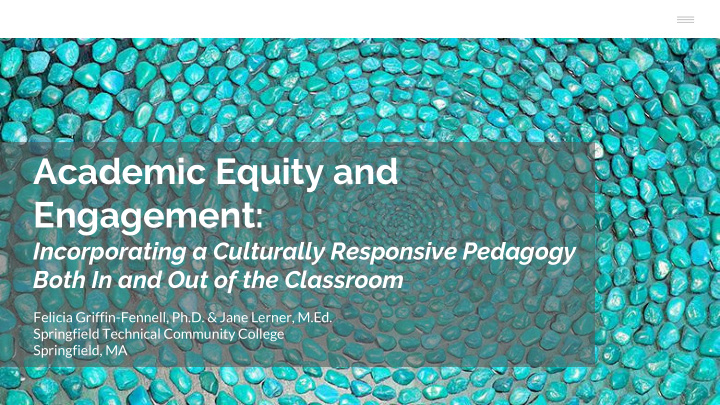



Academic Equity and Engagement: Incorporating a Culturally Responsive Pedagogy Both In and Out of the Classroom Felicia Griffin-Fennell, Ph.D. & Jane Lerner, M.Ed. Springfield Technical Community College Springfield, MA
Who are we? Felicia Griffin-Fennell, Ph.D. Jane Lerner, M.Ed. Director, Hi spanics & L ow- I ncome Director, Decreasing Inequities, ● ● T ransformed E ducation in S TEM Increasing Success project (HiLITES) project DOE-funded, Title III grant project ● DOE-funded, HSI-STEM grant project 2015-2020 ● ● 2016-2021 ●
Takeaways Gain new perspective on defining Identify key campus offices, 1 3 culturally responsive pedagogy organizations, and personnel that are critical for students to know and build connections with Cultivate insight on how to Develop ways to foster new 2 4 develop a classroom environment connections between faculty and that is comfortable for all students students, both in and out of the and meet faculty goals classroom
The Context: STCC Springfield Technical Community College, Springfield MA, is an urban, 2-year public institution with approximately 5,500 students ✼ | Age Range: 17-83 ✼ | Ethnicity: White (42%), Hispanic (29%), Black (17%), Other (12%) ✼ | Gender: Female (58%), Male (42%) ✼ | Enrollment: Part-time (57%), Full-time (43%) ✼ | HSI Designation Year: 2015
The Context: Equity and Student Engagement Through the U.S. Dept. of Education Title III and HSI-STEM grants, STCC embarked upon a multi-year training program for Faculty and Staff, which included: Culturally responsive teaching faculty series ● Establish off-campus collaborators ● Escala Educational Services of New Mexico ○ Unidos Equity Institute of Adams State University ○ POGIL ○ Local community organizations ○ Building Community lunch conversation series ● All-campus professional development days ● We are HSI ○
Questions: How does the idea of culturally responsive teaching 01 03 impact the student experience at college? 02 What role can faculty have in What do we need to include in helping to increase equity and our teaching in order to engagement in the classroom ensure that students connect between students of color and with each other and their white students? faculty?
Influencing Factors on Equity and Engagement 01 | Faculty connections have a direct positive correlation to retention and graduation rates; 02 | Academic rigor and standards need to be developed and maintained in a way that is equitable to all students; 03 | Understanding of the psychosocial cultural factors at play during classroom interactions is critical.
Tenets of Culturally Responsive Teaching (CRT)
Culturally Responsive Teaching (CRT) Competence: Cultivating students’ cognitive abilities to organize and study rigorous content
Culturally Responsive Teaching (CRT) Relatedness: Fostering supportive and positive relationships between professor, students, and rigorous content
Culturally Responsive Teaching (CRT) Trust: Assessment strategies and policies that demonstrate the professor believes that ALL students are capable of learning rigorous content
Tenets of Culturally Responsive Teaching (CRT)
Roles of faculty on college campuses?
Teaching Considerations Participation & engagement ● Assessment ● Subject content ●
Influencing Factors on Student Engagement 01 | Personal challenges that our students bring to the classroom every day; 02 | Explicit and implicit bias, microaggressions, and other forms of discrimination; 03 | The symbiotic affective relationship between students and faculty; 04 | Lack of knowledge regarding campus resources.
Wrap up: Connection between student engagement & CRT It is essential to incorporate the three tenets of ● CRT into the work that you do with your students. Learn who your students are. ● Consider what can you do to make the ● environment comfortable for all students, and meet your own goals for your course content.
Thank you! Any Questions? Felicia Griffin-Fennell (fdgriffin-fennell@stcc.edu) Jane Lerner (jelerner@stcc.edu)
Recommend
More recommend